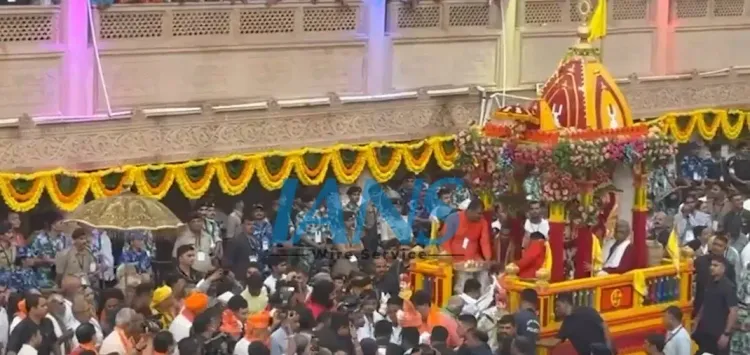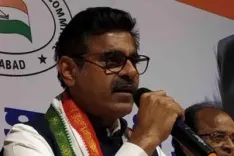What Happened at the 148th Jagannath Rath Yatra in Ahmedabad?

Synopsis
Key Takeaways
- The Rath Yatra is a significant cultural and religious event in Ahmedabad.
- It involves extensive security measures to ensure safety for participants.
- The festival showcases a blend of tradition and modernity.
- Community engagement plays a vital role in the success of the event.
- This year's festival features a variety of cultural displays.
Ahmedabad, June 27 (NationPress) The 148th Rath Yatra of Lord Jagannath made its way through the streets of Ahmedabad on Friday, merging ancient tradition with modern security measures.
Celebrated annually on Ashadha Shukla Dwitiya (Ashadhi Bij), this Rath Yatra is the second largest chariot festival in India after Puri, attracting thousands of devotees from Gujarat and beyond.
The day commenced with the sacred Mangla Aarti, conducted by Union Home Minister Amit Shah around 4:00 a.m., marking a personal ritual.
Shortly after, Gujarat Chief Minister Bhupendra Patel undertook the 'Pahind Vidhi', the symbolic act of sweeping the path with a golden broom, before officially starting the Yatra by pulling the chariot of Lord Jagannath from the historic Jagannath Temple in Jamalpur.
The procession follows a 16-kilometer path through important areas of the walled city, with the holy chariots of Lord Jagannath, his brother Balbhadra, and sister Subhadra passing landmarks like Jamalpur Chakla, Khadia, Kalupur Circle, and Saraspur, where locals traditionally host a grand feast for the deities and pilgrims.
The procession will navigate sensitive areas such as Prem Darwaja, Shahpur, and Manek Chowk under meticulous surveillance.
This year, the Rath Yatra has evolved into a full-fledged 'Lokotsav' (people's festival), showcasing a vibrant cultural display: 18 decorated elephants, 100 tableau trucks, 30 akhadas performing martial arts, along with numerous bhajan mandalis, raas-garba troupes, and traditional bands.
The revered task of pulling the chariots is still led by the Khalashi community, preserving a centuries-old tradition. To ensure the event's safety, the Ahmedabad Police have devised one of the most extensive security plans in recent years.
Over 23,800 personnel, comprising SRP battalions, Rapid Action Force, and Chetak Commandos, are on duty. An additional 4,500 police officers are escorting the procession, while 1,000 traffic police regulate vehicle movement throughout the city.
For the first time, Artificial Intelligence (AI) has been incorporated into crowd control, ensuring real-time monitoring for overcrowding and fire risks.
A network of 227 CCTV cameras, 41 drones, 2,872 body-worn cameras, and 25 watchtowers vigilantly monitor the route. Precautionary barricades have been established around 484 structurally weak buildings, and public assistance centers have been activated for crowd support.
The preparation for the Yatra also involved extensive community engagement, with police conducting over 450 outreach meetings, including Peace Committees, Mohalla Committees, and Women’s Committees, alongside interactive events like cricket matches, blood donation camps, and volleyball tournaments, reinforcing the principles of harmony and civic unity.









